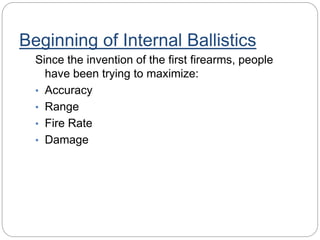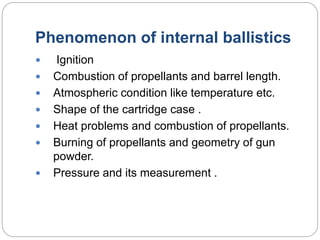Internal ballistic
- 1. Dr.HARISINGHGOUR VISHWAVIDYALAYA SUBMITTEDBY :- JAYSHREE UPADHYAY REG.NO.Y19242510 SUDHANSHU MISHRA REG.NO.Y19242527 MSc-l Sem SUBMITTEDTO:- Dr. Navjot Kaur Kanwal Assistant Professor TOPIC :- internal ballistics ( DEPARTMENTOFCRIMINOLOGYANDFORENSICSCIENCE)
- 2. BALLISTICS ï The science dealing with the motion and impact of projectiles, such as bullets, rockets, bombs.
- 3. BALLISTICS ï The science of projectile and firearm ï Ballistics is the field of mechanics that concerns with the launching, flight behavior and impact effects of projectiles, especially ranged weapon munitions such as bullets, unguided bombs, rockets or the like; the science or art of designing and accelerating projectiles so as to achieve a desired performance.
- 4. History of Ballistics Ballistics began with the invention of the first muzzle loading cannons in the 1200âs A.D. The first handheld guns were muzzle loading rifles and were developed in the 1400âs The first guns were smoothbores
- 5. What is Internal Ballistics? ï Internal Ballistics is the science of what goes on inside the gun ï It includes: ï Lock time, the time from sear release until the primer is struck ï Ignition time, the time from when the primer is struck until the projectile starts to move ï Barrel time, the time from when the projectile starts to move until it exits the barrel.
- 6. Beginning of Internal Ballistics Since the invention of the first firearms, people have been trying to maximize: âĒ Accuracy âĒ Range âĒ Fire Rate âĒ Damage
- 7. Firearm
- 8. The study of the processes occurring inside a firearm when a shot is fired Study of various firearm mechanisms barrel manufacturing techniques; factors influencing internal gas pressure; firearm recoil.
- 9. Phenomenon of internal ballistics ï Ignition ï Combustion of propellants and barrel length. ï Atmospheric condition like temperature etc. ï Shape of the cartridge case . ï Heat problems and combustion of propellants. ï Burning of propellants and geometry of gun powder. ï Pressure and its measurement .
- 10. Ignition ï When the firing pin strikes the hammer, the priming compound explodes with great velocity causing jet of flames often extremely high temperature to pass through the flash hole into propellant chamber. ï This jet of flame with a temperature of about 2000° C ignites the propellant which burns at high speed to form a large volume of high pressure gas.
- 11. Lock time ï Lock time is the time interval between release of the sear and the impact of the striker on the percussion cap. ï Lock time refers to the time interval (often measured in milliseconds) from when the trigger of a firearm is activated until the firing pin strikes the primer, and depends on the design of the firing mechanism.
- 12. Barrel time ï Barrel time is the time interval from the passing of the trigger to the exit of the bullet from the muzzle end.
- 13. Barrel Length ï Measured from the face of the muzzle to the base of the seated bullet Barrel length determines muzzle velocity ï Velocity increases with barrel length up to a certain length dependent on bullet size and propellant ï Typical barrel lengths: 1 8-24 inches for rifles 2-8 inches for handguns Velocity range velocity change per inch ï 0-2000 5-10 ï 2000-2500 10-20 ï 2500-3000 20-30 ï 3000-3500 30-40
- 14. Atmospheric temperature ï The ammunition is manufactured to give the desired velocities and pressures at a particular atmospheric temperature. ï If the temperature differs only slightly at the place of the use, the ballistic aspects are not seriously affected. ï If temperature variations are substantial (e.g., in Ladakh or in Rajasthan desert), they affect the ballistics aspects of the ammunition.
- 15. Atmospheric temperature ï In hot places the pressures developed may be excessive and the firearm may burst. ï In cold places the ammunition may develop low velocities. Indian Ordnance Factories ï manufacture most of their ammunition with a temperature tolerance of â52°Cto72°C.It has been found that the variation in velocities because of the temperature is about one meter per second per degree centigrade.
- 16. Shape of the cartridge case ï It has been observed that if there is an abrupt junction of the neck and the case, the rounds develop greater pressure (for the same quantity of powder). ï The combustion is more uniform, It appears that abrupt neck joint deflects the hot gases inward. ï The hot gases quickly ignite the powder charge in every nook and corner. ï Thus correct initiation and complete combustion of the powder charge takes place inside the cartridge. ï It reduces excessive heating and wear and tear of the barr .
- 17. Shape of the cartridge case
- 18. Cartridges
- 19. Heat problems and combustion of propellants ï During the combustion of propellants, the temperature often reaches to 3000 degree. ï The steel barrels of the firearm easily melt at these temperatures, if gases at this temperature remain in the barrel for any appreciable time. ï But fortunately the time for which the hot gases are in contact with the barrel is about 0.001 second.
- 20. Heat problems and combustion of propellants ï The repeating firearms (automatic or semi- automatic) are eroded more quickly. ï In these the barrels do not get sufficient time between the shots to get cooled. ï The erosion at high temperatures is greater.
- 23. REFERENCE B.R. SHARMA Forensic science in criminal investigation and trials- Forensic medicine and toxicology- R. BARDALE Forensic ballistics âwww.epg pathsala.com Forensic science- www.internalballisticsfirearm.google/images.com
- 24. Thank you.
























